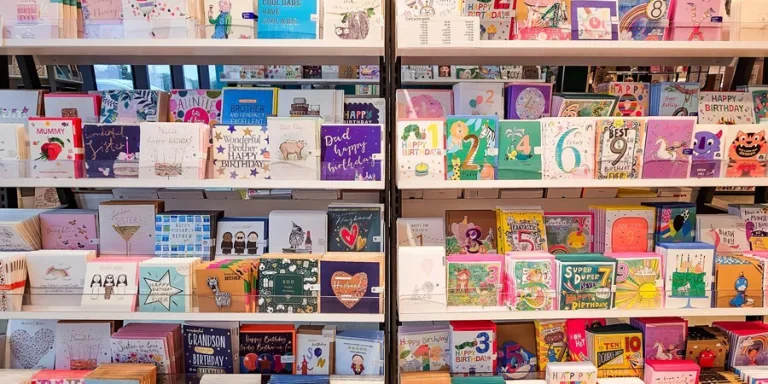Table of Contents
● Introduction
● Market overview
● Key design and material innovations
● Top-sellers driving market trends
● Conclusion
Introduction
As the greeting card industry continues to evolve, 2024 brings forth exciting trends and innovations. With a renewed focus on design, sustainability, and consumer preferences, the market is experiencing significant shifts. This article explores the latest market data, design innovations, and leading brands shaping the future of greeting cards.
Market Overview
Market Scale and Growth
The greeting card industry has shown resilient growth over the years. As of 2023, the global greeting card market was valued at approximately $19.64 billion, with a projected compound annual growth rate (CAGR) of 2% through 2030, according to Exactitude Consultancy. The North America market remains the largest, accounting for 38% of the worldwide market value. This growth is driven by increasing consumer demand for personalized and unique greeting cards, alongside a resurgence in traditional card-giving practices.
Market Shares and Changes
Digitalization and e-commerce have significantly influenced market dynamics. According to statistics from Statista, online sales now represent about 23% of the U.S. greeting card market share, a number that continues to rise as consumers seek convenience and variety. Brick-and-mortar stores still hold a significant share, especially among older demographics who value the tactile experience of selecting cards in person. Notably, sustainability has become a critical factor, with eco-friendly cards gaining substantial market share.

Key Design and Material Innovations
Personalized and Customizable Designs
Personalization is at the forefront of greeting card design. And technology has significantly contributed to the surge in personalized greeting cards. Consumers increasingly seek cards that reflect their unique relationships and sentiments. To cater to this demand, Online platforms now enable users to effortlessly upload photos, edit layouts, and personalize messages. Some platforms have integrated features like augmented reality, adding an interactive and engaging element to the cards.
Companies like Moonpig and Shutterfly offer extensive customization options, allowing customers to add personal photos, messages, and even select the card’s color scheme. This trend is not only enhancing customer satisfaction but also driving repeat purchases.
Eco-friendly Materials
Sustainability is a significant trend shaping the industry. Due to increasing awareness of environmental issues, many North American customers are now seeking greeting cards made from recycled materials or produced through environmentally friendly processes.

Recycled paper or cardboard is frequently used as the primary component in eco-friendly greeting cards. This practice reduces the need for new raw materials, thereby diminishing the environmental impact of paper production. Additionally, some eco-friendly cards are crafted from alternative materials such as cotton, hemp, or bamboo. These materials are more sustainable than conventional tree-based paper, requiring less water and land to produce.
Sustainable card printing often involves the use of vegetable-based inks instead of traditional petroleum-based inks. Derived from renewable resources, vegetable-based inks are significantly less harmful to the environment. This switch not only supports sustainability but also ensures that the entire card, from material to print, aligns with eco-friendly principles.
The packaging of greeting cards plays a crucial role in their overall environmental impact. Eco-friendly greeting cards typically come with compostable or biodegradable packaging, which significantly reduces waste. This approach minimizes the amount of non-biodegradable waste entering landfills and promotes a more sustainable life cycle for the product.
Eco-friendly cards often feature simple designs that require fewer resources to produce. This minimalistic approach aligns with sustainability principles by reducing waste and energy consumption during production. Additionally, some manufacturers incorporate water-saving techniques in their production processes, further conserving valuable resources and reducing the environmental footprint.

Technological Integration
The integration of technology in greeting card design is another emerging trend.
Augmented Reality (AR) and QR codes are being incorporated to enhance the card-giving experience. For example, cards with QR codes can link to personalized video messages or animations.
Additionally, certain platforms allow for the incorporation of social media elements into greeting cards, such as creating photo collages or highlighting shared memories. Moreover, advancements in artificial intelligence are being utilized to suggest designs, messages, or even photos tailored to the recipient’s interests and the nature of the relationship. This personalized approach makes each card unique and meaningful.
From AR to AI, this fusion of traditional and digital elements appeals to tech-savvy consumers and adds a modern twist to classic greeting cards.
Top-Sellers Driving Market Trends
Hallmark and American Greetings: Market Leaders
Hallmark and American Greetings continue to dominate the market, thanks to their extensive distribution networks and wide range of products. They are adapting to current trends by offering eco-friendly options and expanding their online presence. Hallmark’s recent launch of the “Good Mail” collection, which emphasizes sustainability, has been particularly well-received.
Emerging Brands and Innovative Products
Emerging brands like Lovepop and Rifle Paper Co. are making significant strides with innovative designs and unique product offerings. Lovepop’s intricate 3D pop-up cards and Rifle Paper Co.’s artistically illustrated cards have captured consumer interest, particularly among younger demographics. These brands are leveraging social media platforms to reach wider audiences and drive sales.

Seasonal and Niche Cards
Seasonal cards remain a staple, with holidays like Christmas, Valentine’s Day, and Mother’s Day generating the highest sales. However, there is a growing market for niche cards that cater to specific occasions and sentiments, such as “thinking of you” or “just because” cards. This trend reflects a shift towards more frequent, spontaneous card-giving as a means of maintaining personal connections in a digital age.
Conclusion
The greeting card industry is experiencing a dynamic transformation in 2024, driven by personalization, sustainability, and technological advancements. Market leaders and emerging brands alike are adapting to these trends, offering innovative products that resonate with contemporary consumer preferences. For wholesalers and retailers, staying abreast of these trends is crucial for capitalizing on new opportunities and meeting evolving customer demands.
By understanding these trends, businesses can effectively source the best greeting card products, ensuring they remain competitive in this vibrant and ever-changing market.





 Afrikaans
Afrikaans አማርኛ
አማርኛ العربية
العربية বাংলা
বাংলা Nederlands
Nederlands English
English Français
Français Deutsch
Deutsch हिन्दी
हिन्दी Bahasa Indonesia
Bahasa Indonesia Italiano
Italiano 日本語
日本語 한국어
한국어 Bahasa Melayu
Bahasa Melayu മലയാളം
മലയാളം پښتو
پښتو فارسی
فارسی Polski
Polski Português
Português Русский
Русский Español
Español Kiswahili
Kiswahili ไทย
ไทย Türkçe
Türkçe اردو
اردو Tiếng Việt
Tiếng Việt isiXhosa
isiXhosa Zulu
Zulu